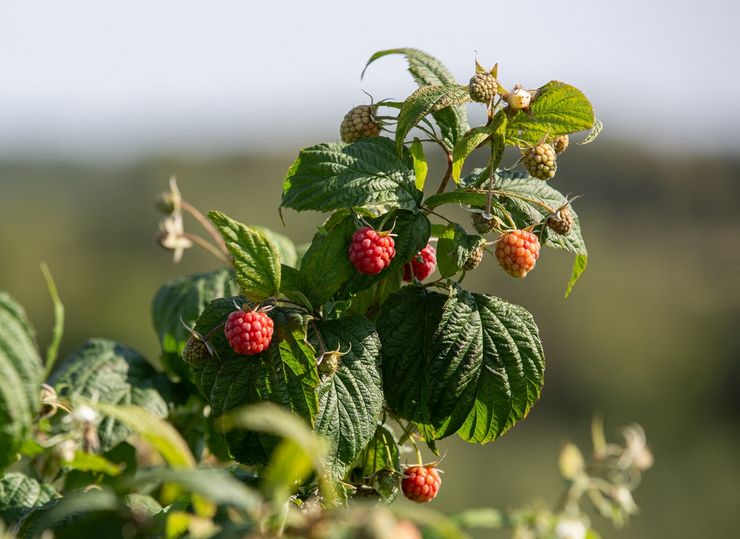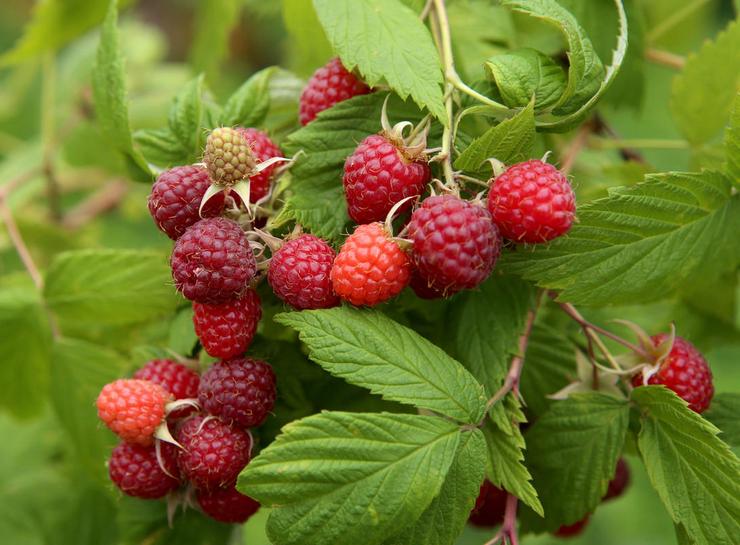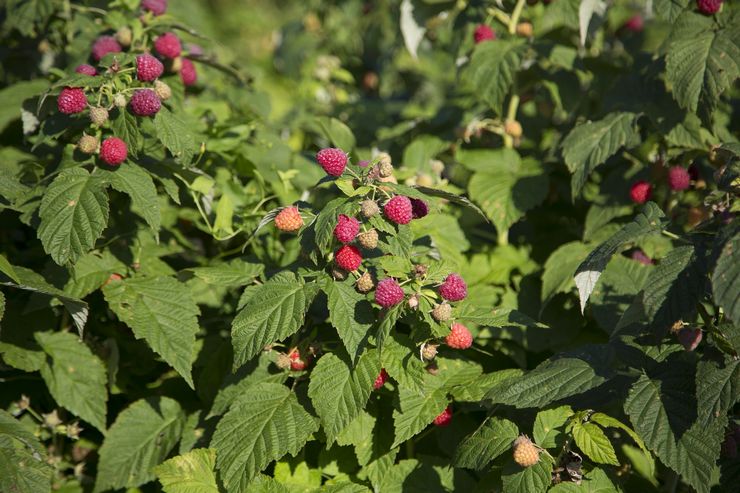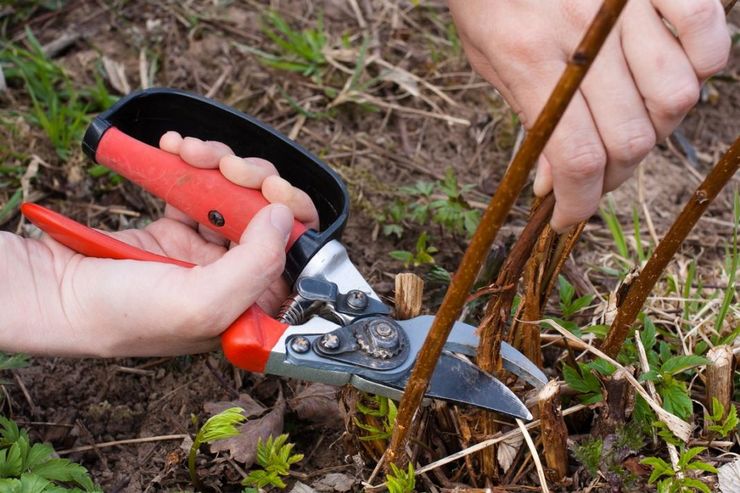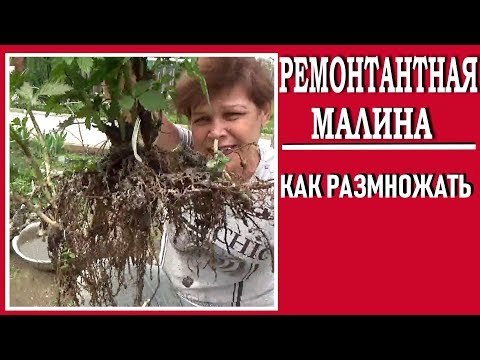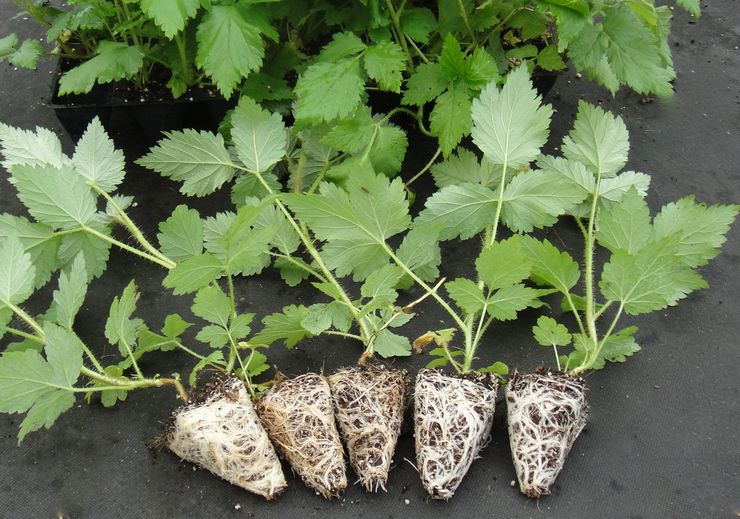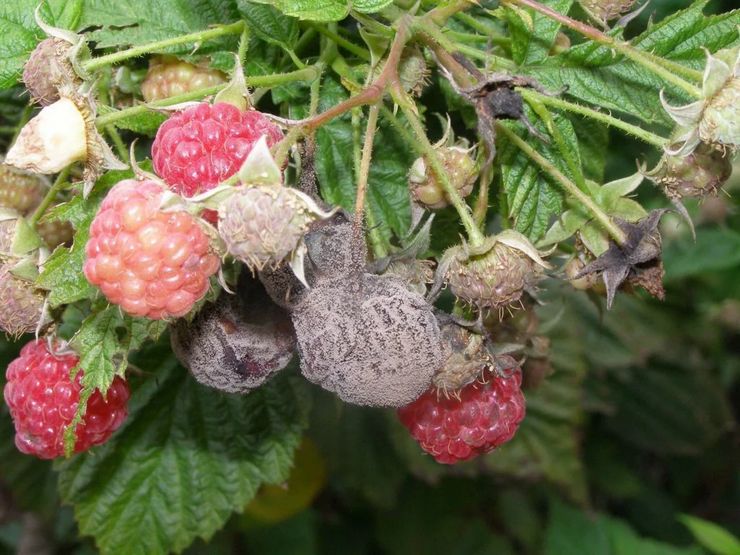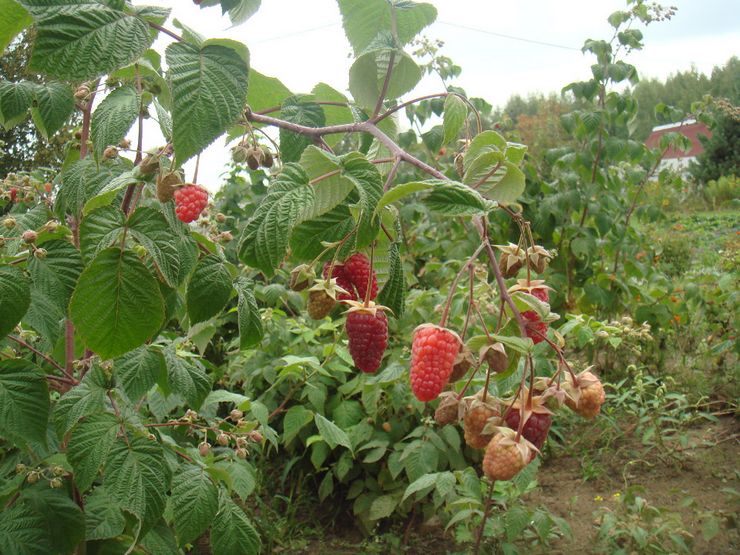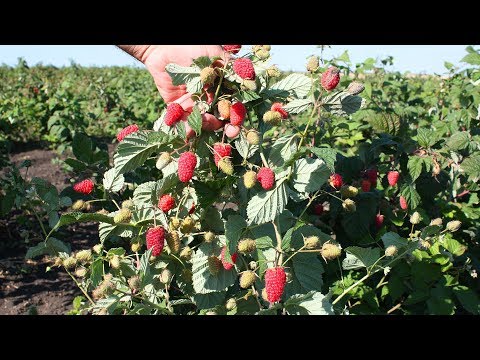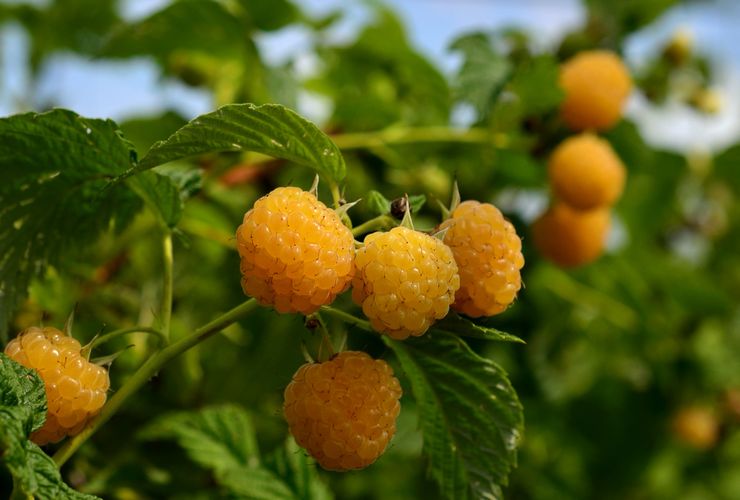Repaired raspberry is a group of raspberry varieties capable of bearing fruit both on annual and two-year branches. These varieties have been known to gardeners for two centuries. Such bushes can be harvested up to twice a year, although the second wave of fruiting is usually considered weaker, and the berries are inferior to the first in taste..
Repaired raspberry varieties have been adapted for the climate of the middle zone since the 70s of the last century. During this period, breeders managed to bring out many new varieties that managed to prove themselves well and become widespread. Among them – and “standard” raspberry, which has strong stems that do not bend due to the weight of the berries.
Description of remontant raspberry
Raspberry is a perennial berry dwarf shrub. The main roots of the plant lie at a shallow depth (about 15-30 cm), but the adventitious roots spread several meters from the bush. Young shoots of raspberries are green in color, becoming rustic by the next season. After fruiting, which begins in the 2nd year, they dry out, giving way to fresh shoots from the same rhizome.
Repaired varieties differ from ordinary raspberries in only a few characteristics. So some of them practically do not form basal shoots or reproduce very poorly. Every spring, these raspberries form fresh shoots that yield a harvest. By winter, the tops of fruiting shoots dry up, and the rest of the branches by the next season forms new fruit branches – just like ordinary varieties. In addition, most of these varieties have large fruits..
Last year’s branches of remontant raspberries bloom earlier than young shoots. Flowers appear on them already at the end of spring, and on the rest – by about mid-summer. Because of this feature, such varieties are harvested twice. But the weakness of the second wave of fruiting often forces gardeners to use such bushes as an “annual”. If you cut off all the branches of such raspberries for the winter, actively developing young shoots in the next season will begin to bear fruit earlier than usual and give an excellent harvest. But due to the shift in the timing of fruiting to a later period in some regions, the risk of losing part of the crop in the event of early frosts increases..
The peculiarities of fruiting are not the only advantage of remontant raspberries. Compared to ordinary bushes, it is considered more resistant to pests and diseases, and its berries are practically not affected by worms. Caring for such a raspberry is quite simple, so today it can be found in many gardens as a popular berry bush..
Raspberry remontant – description, cultivation, care.
Brief rules for growing remontant raspberries
The table shows brief rules for growing remontant raspberries in the open field..
| Landing | Planting is carried out in early spring or first half of autumn.. |
| Lighting | You need to grow remontant raspberries in a very bright place.. |
| Watering mode | Water abundantly about once a week at normal times and slightly more often during dry periods. They try to constantly keep the soil in a slightly moist state, during watering it should be soaked by about 35 cm. The most important thing is to provide raspberries with moisture before flowering, as well as during the development and ripening of berries. In the middle of autumn, watered before wintering. It is recommended to use drip irrigation. |
| The soil | A light, nutrient-rich loam with a pH of 5.8 to 6.7 is required. It is advisable that before planting, the site is at least a season under black fallow. The groundwater level should not exceed 1 m. |
| Top dressing | If the seedlings were planted in nutrient soil, they are not fed for a couple of years. Then every year they are fertilized with organic compounds: a solution of chicken droppings or a mullein that has time to ferment (1:20 and 1:10, respectively). Superphosphate is introduced only during planting, of other mineral fertilizers, raspberries only need potassium, and chlorine should be avoided. |
| Pruning | In spring, when the buds awaken, sanitary pruning and removal of basal shoots is carried out. After harvesting, all the shoots of the bushes are cut off – in the spring they will be replaced by new ones. |
| Reproduction | Green cuttings, root shoots 4-5 years old (if any). |
| Pests | Aphids, mites, caterpillars, raspberry bugs. |
| Diseases | Fungal and viral infections. |
Planting remontant raspberries in open ground
When is the best time to plant
To grow raspberries, you need a light, but moist and nutritious soil. Repaired varieties are planted in a bright and warm corner of the garden, sheltered from strong winds. In the shade, the berries will turn out to be smaller, and they will ripen later. Bushes will grow best on fertile loamy soil with a pH of 5.8 to 6.7. Too acidic soil is preliminarily lime, adding dolomite flour, limestone, etc. to it.Such varieties are considered a little more demanding on growing conditions than ordinary raspberries, so the place for planting them must be chosen especially carefully.
The groundwater under the future raspberry tree should lie no higher than 1 meter. You should not grow raspberries in the part of the garden where nightshades (tomatoes, potatoes or peppers) used to grow, as well as in the place of an old raspberry or strawberry planting area. The land after growing these crops will be too poor to plant new bushes. It is advisable to keep the area under black steam before planting, without planting anything on it during the season, but continuing to dig the ground to avoid the appearance of weeds. Another way is to fill the future raspberry patch with green manure plants (rye, mustard or lupine), covering their bushes in the ground 1.5 months before planting. If raspberries are planted without preliminary preparation, an area of the garden is selected for it, where perennial herbs grew.
Planting bushes can be carried out in early spring – this will allow you to get the first harvest in the same year, but the beginning of autumn is still considered the optimal time for planting seedlings..
Spring planting
Raspberry repair / Raspberry repair care / Planting / Pruning / Fertilizers
The site for the spring planting of remontant raspberries has been prepared since autumn. To do this, the earth is cleared of weeds and dug onto a shovel bayonet, immediately adding the necessary additives there – about 2.5 buckets of humus or high peat, superphosphate and potassium sulfate (1 glass each) or about 300 g of a complex mineral composition per 1 sq. m.
In the spring, pits about 40 cm deep and wide are prepared for the bushes. A distance of about 70 cm is maintained between the bushes, and from 1.5 m between the rows. For planting, seedlings with well-developed roots are used. The diameter of the main shoot near the base should be at least 0.5 cm, and its length should reach 20 cm.
To check the suitability of the seedling, you can cut off one bud from it and pry the bark on the shoot itself. The inner side of the bark should be green and the bud should not be dry. If the roots of the plant managed to dry out during the transportation period, the seedling is placed in water for a couple of days with the addition of a root formation stimulator. You can also pre-treat the plant with fungicides..
The seedling prepared in this way is placed in a hole and sprinkled with nutritious soil so that the root collar is equal to the ground level. If raspberries are planted in sandy soil, the neck can be buried no more than 4 cm.After that, the seedling is well watered, and after absorbing moisture, its root area is mulched.
Autumn planting
The procedure for planting remontant raspberries in autumn is practically the same as in spring, but the site has been prepared for this since spring. It is the autumn planting that allows the seedlings to take root better, as well as give a higher yield for the next year. They start growing right after winter, while spring saplings will gain strength only for the next season – some of their time will be spent on rooting. In addition, autumn plantings require less watering due to rains, are not exposed to scorching rays, and planting material during this period is presented in a larger assortment..
Exact landing times vary by region. The seedling should be in the ground at least 2-3 weeks before the start of frost. The readiness of raspberry bushes for planting can be seen by the formation of replacement buds on the root collar..
Caring for remontant raspberries
Spring care
Raspberry repair procedures begin in early spring. Even before the snow melts on the frozen ground, the bushes are fed, pouring a complex mineral composition next to them.
In April, closer to the awakening of the bush, sanitary pruning is carried out – dry shoots are removed, and the remaining branches are cut to the first living bud. If in the fall raspberries could become infected with a fungus, in mid-spring the bushes and the adjacent soil are sprayed with a 1% solution of ferrous sulfate or nitrafen. In other cases, plants are sprayed with fungicides in early May for prophylaxis. To do this, you can use drugs such as Actellik, Topaz or Ridomil..
Repaired raspberries will need not only regular, but also foliar feeding with a complex mineral composition, including growth-stimulating substances. By the end of May, plants are treated for pests using bio-based insecticides. Among such drugs are Aktofit (a rapidly disintegrating neurotoxin that is safe for humans and animals, as well as for the plants themselves) and Lepidocide (a powder pesticide that does not accumulate in plant tissues).
From spring, they begin to take care of the raspberry tree weekly: watering and periodic weeding, and also slightly loosen the soil. The abundance of weeds and the compaction of the earth is bad for the development of the bushes. The first loosening is carried out after the snow melts, before the buds begin to bloom. In the row spacing, the soil is loosened by about 10-15 cm, and in the bushes – no deeper than 8 cm, so as not to damage the roots. Mulching will help to reduce the number of such procedures; without it, the earth is loosened about 4-6 times over the summer..
Raspberries in the spring: care, pruning, feeding
Summer care
In summer, remontant raspberries continue to be watered regularly, and also to monitor the looseness of the soil. Tall bushes should be tied to supports. To simplify the procedure, the creation of fasteners will allow: along the entire row, high pegs are driven into the ground, which are fastened together by 2-3 rows of rope or wire, located half a meter from each other.
Since remontant raspberries can begin to bear fruit early enough, pest or disease chemicals on these plants should be avoided. All treatments are carried out in advance, trying to prevent such problems, or they use biological agents that are safe for humans, strictly following the instructions.
If raspberries grow in the very sun, a temporary shelter will help protect it from the midday heat – a net or light spunbond, without them the berries on the bushes can literally burn out. The net will also serve as a good protection from birds..
Autumn care
Fruiting of remontant varieties of raspberries sometimes lasts until late autumn. The shoots from which all the berries were collected are often completely cut off before the onset of cold weather. In young bushes planted in the current season, the stems are shortened to 20 cm in height. In this case, the full cutting of the branches is carried out only after a year..
After pruning, the remontant raspberry bushes are cleaned of all plant debris, and the old layer of mulch is also removed, where insects or harmful bacteria can also hide. Peeled and pruned plants are watered abundantly before hibernation to create an adequate supply of moisture for them. After that, the last loosening of the season is carried out, trying to completely turn over the soil layers. A 10-centimeter layer of mulch is laid on top for the winter: humus or partially rotted manure.
Watering
Without enough moisture, remontant raspberries will not be able to develop normally. Usually, watering is carried out about once a week, but in dry weather, their number is increased, trying not to let the soil near the bushes dry out completely. The most important thing is to monitor the moisture level, from flowering to the end of development and ripening of berries. When watering, the soil should be moistened about 35 cm deep. The last watering of the season is carried out in late autumn, abundantly moistening the soil before wintering.
Despite the moisture-loving nature, raspberries should be protected from waterlogging and stagnation of liquid at the roots. Such conditions are considered even more dangerous for plants than drying out of the soil. Too wet soil makes it difficult for oxygen to reach the roots of the plant, the temperature of the soil decreases, and this leads to a slowdown in the development of plantings. Most often this happens in spring, when the earth does not have time to dry out enough between watering or precipitation..
To avoid such problems, it is recommended to use drip irrigation for remontant raspberries. It not only saves water, but also allows the soil to be wetted evenly. Without it, raspberries are simply watered from a bucket, hose or through irrigation ditches. For this, rows of bushes are surrounded by earthen grooves about 10-15 cm deep. Water that has had time to warm up is poured into them. Timely mulching will help reduce the number of watering.
Top dressing
If the site for planting remontant raspberries was initially dug up with the addition of fertilizers, the first two years young bushes can not be fertilized at all. Regular feeding begins to be carried out only from the 3rd year. Organic matter is well suited to raspberries – these compositions contain all the nutrients necessary for the bush, in addition, it has a positive effect on the soil structure. Chicken droppings diluted with water 1:20, or fermented mullein (1:10) can be added to the soil. Such compositions can be applied 2-3 times per season, spending 3-5 liters per 1 sq. m. territory. Periodically renewed mulch from compost or humus can replace such top dressing..
In addition to organic compounds, raspberries are also fed with minerals. Most often, superphosphate is added under the bushes only during the initial planting, but raspberries will need potassium supplements on a regular basis. From the lack of this element, the foliage of the bushes becomes shallow, dries up between the veins and turns brown at the edges. But for dressings, only formulations without chlorine can be used, for example, potassium sulfate or potassium magnesium.
In order to fully meet the needs of remontant varieties of raspberries in minerals, at the beginning of spring, Nitroammofoska or other agents with a similar composition are introduced under the bushes, or each of the elements is added separately. It can be superphosphate (about 50-70 g per 1 sq. M), potassium sulfate and urea (about 30 g each).
After THIS SPRING RASPBERRY FEEDING, you will harvest berries in buckets!
Transfer
Repaired raspberries can grow in one place for about 10-15 years. When the planting yield begins to decline, or the size of the berries becomes too small, the bushes must be dug up and divided. All cuts on the received divisions are powdered with crushed coal, and then they are seated in separate pits..
In some cases, remontant raspberries are transplanted not because of the old age of the plantings, but because of the initially wrong choice of place. Any transplants are carried out at the same time as the planting of seedlings – in the spring or in the first half of autumn.
Pruning remontant raspberries
Spring pruning
The branches of remontant raspberries that survived the winter may dry out, freeze or crack during this period. All affected or dry areas of the bush are cut in the spring to the upper living bud. At the same time, healthy stems are not touched – trimming their tops during this period will only delay the formation of berries and can adversely affect the yield of the bushes. To be sure to cut off only dry or damaged shoots, for this procedure, you should wait for the buds to awaken..
If the cultivar of remontant raspberry is producing a lot of root growth, most of these shoots should be removed. For 1 sq. m there should be no more than 10-15 branches, half of which will be one-year replacing, and the second – two-year-old fruitful. The absence of overgrowth allows you to keep the raspberry plant neat and well-groomed, but sometimes it creates additional difficulties when breeding bushes.
Pruning in the fall
How to prune remontant raspberries. Site "Garden world"
After complete harvesting, all stems of remontant varieties of raspberries are recommended to be cut at the root. In the spring, such plantings will give fresh shoots, which during the season will have time to develop enough for fruiting and form many berries. In the absence of old branches in a clean area, the pests will have nowhere to winter, which will allow the bushes to form a healthy aboveground part in the spring. This approach will also be able to protect plantings from pests that become active during the ripening of the berries of ordinary bushes, but requires more time from the bushes to build up the green mass in the next season..
If in autumn the old branches are only partially shortened without cutting them completely, the first fruits on the bushes may appear as early as June. Such plants are more often the target of harmful insects that feed on foliage in spring, but with early autumn frosts, only leaving a part of last year’s branches will save the future harvest. Because of these features, each gardener chooses the optimal way of pruning remontant raspberries for himself..
If the raspberries still did not have time to fully ripen before the first frost, the branches from the bushes are cut directly with berries and leaves, and then they are brought into a warm room and placed in buckets of water. Under such conditions, some of the berries can have time to ripen even on cut shoots, preserving all the useful substances and taste..
Wintering of remontant raspberries
Most remontant varieties of raspberries have a good degree of winter hardiness, so the plants will not need a full-fledged shelter. For the winter, it is enough to properly mulch them. At the risk of a little snow and frosty winter, the root area is additionally insulated with a layer of hay pressed to the ground by some kind of load. If the raspberry branches were not completely cut off for the winter, they are bent to the ground, covered with wooden boards, and thrown on top with a layer of foliage or spruce branches.
Reproduction of remontant raspberries
Reproduction by root suckers
Although most varieties of remontant raspberry do not form root shoots, some bushes do form such shoots. The maximum of these shoots is formed by bushes 4-5 years old. For 1 sq. m. area they can appear from 2 to 15 shoots. When such shoots reach a height of 5-10 cm, they are dug up and transplanted into a growing bed. A cloudy day is best suited for this procedure. After transplanting, the offspring are looked after in the usual way – they are watered as needed, mulched, and also shaded from bright rays. After rooting, which takes a couple of weeks, the seedlings will not need protection from the sun. By the fall, when the offspring grow up, they can be moved to their final place..
Propagation by root cuttings
Repaired raspberries in spring Reproduction of repaired raspberries
In the fall, while loosening the earth under the remontant raspberry bushes, a root of 2 cm in diameter should be dug out of the ground, divided into pieces about 10 cm long and planted in one row in a groove about 7 cm deep. After that, the roots are sprinkled with soil, watered and mulched the garden. All the next summer, when root cuttings give shoots, this row is cleared of weeds, loosened, watered and fed, and also carry out appropriate treatments against harmful insects and diseases. In the fall, it will be possible to transfer the bushes to their final location..
Propagation by green cuttings
To propagate the remontant variety by cuttings, they are cut at the end of May, choosing annual shoots that grow from the ground and have a leaf rosette. The height of the shoot itself should be about 4 cm, it is cut 5-6 cm below the ground level and pulled out directly with a soil clod. The cuts are sprinkled with crushed coal, and then the cutting is transplanted into the greenhouse to the same depth. If several cuttings are taken from a bush at once, they are placed at a distance of 5 cm with a 10-centimeter row spacing.
Best of all, such cuttings take root in light sandy-peat soil. They are watered, they make sure that the seedlings do not wither under the scorching rays, and after rooting, they begin to open the greenhouse for ventilation in order to accustom young plants to new conditions. After the seedlings can spend at least a day in the air, they can be transplanted to a permanent place..
Old bushes of remontant raspberries are also propagated by division – this procedure contributes to the rejuvenation of plantings and is carried out in spring or autumn.
Diseases and pests of remontant raspberries
Diseases
Although remontant raspberries are considered more disease-resistant than common raspberries, sometimes even these bushes can become infected. Fungal diseases are considered one of the most common. These include purple spotting (didimella), septoria, verticilliasis (wilt), and anthracnose. Fungicidal preparations will help protect against their pathogens – solutions of Bordeaux liquid, Amistar, Topaz, Fundazol and other similar agents.
Bacteria can also harm raspberries. Among the diseases they cause is goiter of the roots (root cancer). Such diseases are easiest to prevent by carefully examining the planting material before purchasing, maintaining immunity with proper care, and also regularly carrying out preventive treatments..
The most dangerous for remontant raspberries, as well as for other garden plants, are diseases caused by viruses. These include curliness, mosaic, infectious chlorosis, and bushy dwarfism. At the first sign of such diseases, the affected plant is dug up and destroyed in order to prevent infection of the rest. Overgrowth – mycoplasma disease is also considered incurable. In this case, a lot of thin shoots with a height of about 40 cm appear on the bush, on which fruits are not formed..
In order not to face the loss of bushes, it is important to prevent the development of such diseases in a timely manner. To do this, the raspberry tree is systematically examined for lesions in order to immediately notice signs of a dangerous disease. In the place where the affected bush grew, raspberries are not planted for several years.
Adherence to agricultural practices, regular feeding, as well as weeding will help improve the resistance of plants – weeds, like harmful insects, can become carriers of infections. The density of the raspberry tree should also be monitored. Although many remontant plants do not form numerous shoots, planting too tightly makes it difficult for air to flow between the bushes and contributes to the spread of diseases. Correct and timely pruning can also protect against diseases..
In addition, it is recommended to grow remontant varieties separately from the usual ones. Common raspberries are more quickly affected by harmful insects or diseases, so they can provoke infection and more persistent plantings..
Pests
Among the pests of remontant raspberries are raspberry bugs, caterpillars, aphids, as well as raspberry and spider mites. But after the beginning of the flowering of the bushes, it is not recommended to use insecticides in the fight against such harmful insects..
Having noticed the attack of pests in a timely manner, you can use herbal remedies that will help drive them away from the bushes. So an onion or garlic infusion will help against a tick. 100 g of onion husks or crushed garlic are added to 10 liters of water and infused for about 2-3 days. Straining the infusion, add 50 g of liquid soap or laundry soap dissolved in water.
Caterpillars, aphids and other insects that gnaw foliage and feed on its sap should leave the bushes after being treated with a solution of wood ash with kerosene. It is prepared in several stages. First, 1 liter of wood ash is added to 5 liters of water. At the second stage, 50 g of green or laundry soap is added to 1 liter of clean water. Then 1 teaspoon of kerosene is separately diluted with a small (30-50 ml) amount of water, shaking until smooth. The first two solutions must be filtered and mixed, after which water with kerosene is added to them and the mixture is diluted with water until 10 liters are obtained. Plantings are sprayed with a solution immediately after mixing.
If pests have encroached on the bushes before they begin to bloom, you can spray the raspberries with insecticidal preparations on a biological basis (Aktofit, Bitoxibacillin, Lipidocid, etc.).
Varieties of remontant raspberries with a photo
Early varieties
Ripening of such varieties of remontant raspberries with full autumn pruning begins from late July – early August. Among the most common:
- Apricot – especially resistant to pests and infections. Its thorns are located closer to the bottom of the branches, making it easier to pick berries. Fruits are medium-sized – about 3-4 g in weight. The deadline for their collection falls at the beginning of August. The berries have the shape of a blunt cone, an unusual golden-amber color and an apricot note on the palate. Fruiting lasts until frost.
- Brilliant – bushes up to 1.5 m tall form a large number of berries ripening from the first decade of August. The thorns are soft enough, located near the base of the shoot. Berries appear at half the length of the branch. They have the shape of a cone, a deep ruby color with brilliance and a weight of up to 7 g. The taste is sweet, slightly sour..
- Bryansk jubilee – forms compact bushes of medium height, ripening by the end of July. Elongated red berries can be medium or large, their weight reaches 6 g, and the taste is sour-sweet.
- Hercules – a variety with large berries, characterized by high productivity and resistance to pests. The bushes have straight and strong shoots that do not need to be supported. Fruits appear at half the length of the branches. The shoots have thin and sharp thorns. The berries are dense, up to 10 g in weight. They have the shape of a truncated cone and have a rich ruby color. The taste of the berries is sweet and sour. They appear from August until the very frost..
- Eurasia – disease-resistant early ripening variety with large berries. Differs in standard shoots, along the entire length of which there are rare thorns. Dense sweet and sour cone-shaped fruits have a dark raspberry color and a weight of 6 g and more.
Mid-season varieties
The berries of these varieties of remontant raspberries begin to ripen by mid-August..
- Firebird – a variety with large berries up to 6 g in weight. They have a cone shape, delicate flesh and a sour-sweet taste. Thorns are located 2/3 of the length of the branches, starting from the base, they are thin and rather soft.
- Golden autumn – the variety is distinguished by small soft thorns, concentrated at the base of the bush, as well as numerous golden berries with the shape of an elongated cone. The berries weigh up to 7 g. They have a pleasant dessert taste and a characteristic raspberry smell..
- Mulatto – a variety of abundant fruiting, resistant to pests and diseases. The shiny berries are cherry-colored, they can be medium or large, and their weight is about 5 g. The taste of the fruit is sour-sweet.
- Orange miracle – a variety with large, sour-sweet orange berries. Their weight can be up to 12 g, and their length is up to 4 cm. In shape, the berries resemble blunted cones. Fruiting continues until frost.
- Ruby necklace – a very productive variety with thorns located at the base of the branches. The berries weigh up to 8 g, they have a refreshing taste (sweet with sourness) and are painted in a bright ruby color..
Late varieties
In terms of quantity, the late remontant varieties of raspberries are inferior to those described above. Berries on such bushes ripen by the very end of August or by September.
- Zyugan (or Shugana) – a variety produced by Swiss breeders that is drought tolerant. Berries appear in the second half of August, so this raspberry is considered medium-late. With proper care, the weight of its berries reaches 10 g..
- Autumn Treasure – a variety resistant to harmful insects and diseases, with dense berries of light red color. Their weight reaches 5 g, and the shape resembles an elongated cone. The fruits ripen by the end of summer. The variety has a hybrid origin and is derived from raspberries Glen Moy and Autumn Cascade.
- Morning dew – Polish variety with yellow berries up to 8 g in weight. They ripen towards the end of summer and have high taste characteristics..
- Heritage Is a frost-hardy American variety with good immunity, bred on the basis of Darham, Milton and Cuthberg raspberries. The berries are colored red and have a pleasant aroma; they begin to harvest from late summer – early autumn.
- Erika – is considered one of the most remarkable varieties in Western Europe. The shiny berries are dark red, have a pleasant taste and are large in size..
The best varieties for the middle lane
Many remontant varieties of raspberries take root well in the middle lane. For example, for planting in the Moscow region and other regions with a similar climate, you can choose such raspberries as:
- Atlant – a productive variety with good immunity. Short thorns on the branches are rare and concentrated only at the base of the branches. Juicy berries in the shape of an elongated cone have a dense structure, large size and weight up to 9 g. Their taste is sweet and sour..
- Indian summer – an early ripe variety, resistant to raspberry mites and many diseases, the berries are ruby-colored and have an excellent taste, but almost no smell.
- Bryansk marvel – a variety with strong branches that do not need tying. The berries are very large, weighing up to 20 g. They have an elongated conical shape, and ripen from mid-summer to October..
- Penguin – an early standard variety with medium-sized thorns, painted in a dark color. They are located at the bottom of the branches. The berries are dark crimson, in the shape of a rounded cone, dense and medium in size. The cultivar is also notable for its resistance to pests and diseases..
- Polka – a hybrid Polish variety that forms many shoots. It is based on the varieties Autumn Bliss and an experimental variety from the P line. It is harvested from August until the first frost. Berries are shiny, elongated and large (up to 12 g in weight), colored in a rich purple color.
The best varieties for Siberia
In regions with particularly harsh winters, the earliest possible awakening of such raspberries is considered the key to a good harvest of such raspberries. Such varieties are not afraid of a short summer as:
- Augustine – a variety with short thorns. Sweet berries in the form of a wide cone with a blunt end have a weight of about 4.5 g, a dark crimson color and delicate flesh.
- Reliable – plants resistant to weather changes, giving consistently good harvest. Berries are shiny, red, weighing up to 5 g have a characteristic aroma and excellent taste.
- Unattainable – early variety, forming bushes up to 160 cm tall. The crop is harvested from late July to October. The berries have a bright red color, delicate structure and sour-sweet taste, their weight reaches 7 g.
- Monomakh’s hat – a variety of good yields, almost devoid of thorns. Grows in the form of a medium-sized tree, forms large red berries weighing up to 20 g.
Most popular varieties
The best varieties of remontant raspberries Variety Pohvalinka Growing tips
The number of remontant varieties of raspberries is constantly growing, among them there are plants with improved characteristics; the different preferences of gardeners do not allow highlighting the best varieties. Nevertheless, many of these varieties have earned their popularity due to the reliability of cultivation and high quality indicators of berries. Among them are such raspberries as:
- Apricot;
- Atlant:
- Indian summer;
- Hercules;
- Yellow giant;
- Penguin.
New items
The impressive advantages of remontant raspberries – yield, good immunity and ease of picking berries contribute to the spread of such varieties and stimulate breeders to develop more and more new forms of such plants. Many of the varieties listed above were obtained relatively recently. The following varieties are also considered novelties on the remontant raspberry market:
- August miracle – compact bushes, bearing fruit almost along the entire length of the branches. Berries up to 4 g in weight are resistant to worminess, and ripen by the beginning of August.
- Golden domes – medium-sized bushes that need support. Berries appear more than half the length of the shoot.
- Autumn beauty – meter bushes with large berries that have a pronounced taste and aroma.

